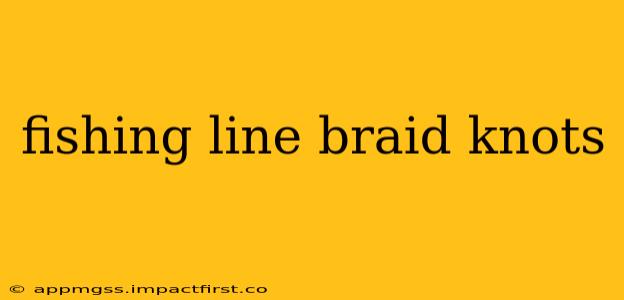Choosing the right fishing line is crucial for a successful fishing trip, but equally important is mastering the art of tying strong and reliable knots. Braid fishing line, known for its strength and sensitivity, requires specific knots to maximize its performance and prevent line breakage. This comprehensive guide explores various braid knots, offering detailed instructions and tips for each. We'll cover everything from the basics to advanced techniques, ensuring you're equipped to handle any fishing situation with confidence.
What are the Best Knots for Braid Fishing Line?
Several knots are particularly effective for braid, each with its own strengths and weaknesses. The best knot for you will depend on the type of fishing you're doing, the size of your line, and your personal preference. However, some consistently rank highly among experienced anglers:
1. The Uni Knot:
The Uni knot is a classic and incredibly versatile knot suitable for connecting braid to a variety of lures and swivels. It's relatively easy to learn and incredibly strong, making it a staple for many anglers.
How to Tie a Uni Knot:
- Pass the braid through the eye of the hook or lure.
- Make 5-7 wraps around the standing line (the part not going through the eye).
- Pass the tag end (the end coming from the hook/lure) through the loop created near the base of the wraps.
- Moisten the knot and carefully tighten it by pulling both the standing and tag ends. Trim the excess tag end.
Pros: Strong, versatile, easy to learn. Cons: Can be slightly bulky in smaller line sizes.
2. The FG Knot:
The FG Knot (Fuji Grip Knot) is renowned for its exceptional strength and minimal bulk. It's widely considered one of the strongest knots for connecting braid to fluorocarbon or monofilament leaders. While slightly more complex to learn, the superior strength makes it worthwhile for serious anglers.
How to Tie an FG Knot: (Detailed instructions require diagrams and are best found via a visual guide on YouTube. Searching "FG knot tutorial" will yield excellent results.)
Pros: Incredibly strong, minimal bulk, excellent for leader connections. Cons: More challenging to learn than the Uni Knot.
3. The Albright Knot:
The Albright knot excels at joining two different diameter lines, making it perfect for connecting braid to a thicker monofilament or fluorocarbon leader. It's particularly useful when targeting larger fish where a stronger leader is necessary.
How to Tie an Albright Knot: (Again, a visual tutorial is highly recommended. Search "Albright knot tutorial" on YouTube.)
Pros: Excellent for joining different line diameters, strong and reliable. Cons: Can be slightly more time-consuming to tie than simpler knots.
4. The Double Uni Knot:
This knot doubles the security of the standard Uni knot, providing extra strength for critical situations. It’s particularly useful when using heavier line or targeting particularly strong fish.
How to Tie a Double Uni Knot: (Essentially, you're tying two Uni knots back-to-back; visual guides are recommended.)
Pros: Extremely strong, increased security over a single Uni knot. Cons: Slightly more complex and time-consuming than a single Uni knot.
Frequently Asked Questions (FAQs)
What is the strongest knot for braid?
While no single knot is universally the "strongest," the FG Knot consistently ranks highly for its exceptional strength and minimal bulk, especially when connecting braid to other line types. However, proper knot tying technique is crucial; a poorly tied knot of any type will fail.
Which knot is best for connecting braid to leader?
The FG Knot and the Albright Knot are both excellent choices for connecting braid to a leader. The FG Knot is stronger and less bulky, while the Albright Knot is better suited for joining significantly different line diameters.
How do I prevent braid from fraying?
Properly trimming the tag end close to the knot with sharp scissors helps prevent fraying. Using a lighter to lightly melt the very end of the braid after trimming (be extremely careful!) can also seal it and prevent fraying.
Should I wet my braid knots?
Yes, always wet your braid knots before tightening. This reduces friction and helps prevent the knot from breaking during tightening.
Conclusion
Mastering these braid knots is essential for any serious angler using braided fishing line. Remember that practice makes perfect – the more you tie these knots, the faster and more proficient you will become. Choose the knot that best suits your specific needs and always double-check your knots before casting your line. Tight lines!
